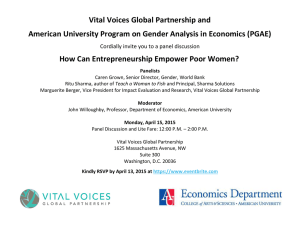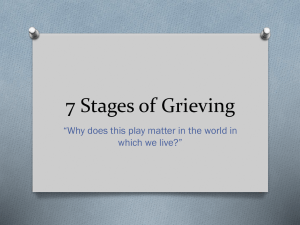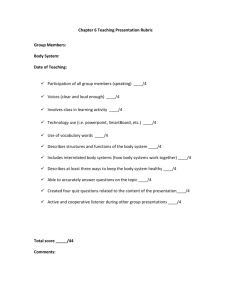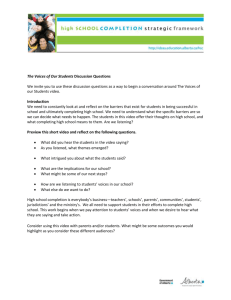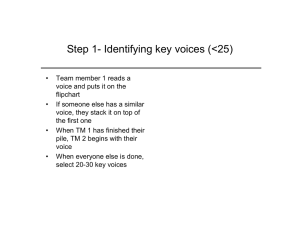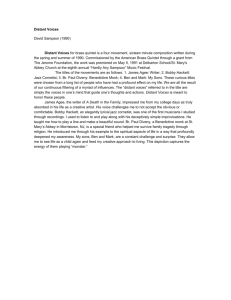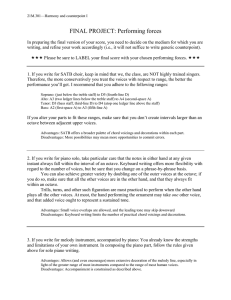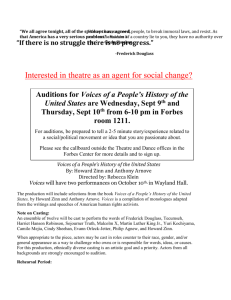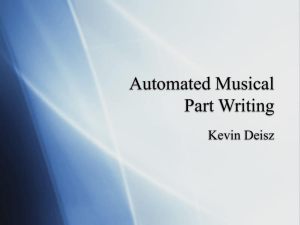Slides
advertisement
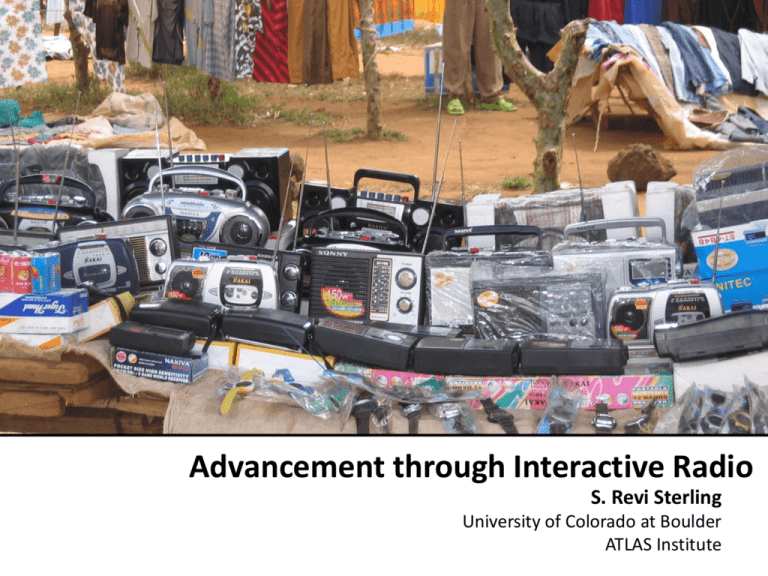
Advancement through Interactive Radio S. Revi Sterling University of Colorado at Boulder ATLAS Institute AIR Space • AIR operates at the intersection of women, technology and participatory development. • Women’s advancement is recognized as central to sustainable development. • Radio most popular mass medium: “Africa’s Internet;” increased focus on Community Radio by agencies and development experts alike Enables women’s voices and knowledge to be publicized, recognized in a culturally appropriate venue without incurring the barriers to ICT access that are unique – and possibly harmful – to women: cost, literacy, time, location, safety and perceived relevance What AIR is • A custom communications device to assist in women’s, and thus community, advancement • A mechanism that enables women to “talk back” on radio airwaves, giving radio limited interactivity • Research that tests several social and development theories • A system: handset, hardware, software, community radio • Based on women’s requirements • An interim solution until: • Rural communities are on cellular and electrical grid • Women can afford cell phones • Women are permitted to be more active, vocal and mobile members of their communities What AIR is not • A cell phone – Sub-Saharan Africa may be the fastest growing cell market, but 50% of region has no cell coverage (World Bank, IEEE 2007) – Women’s ownership issues: “men will take then and sell them” – Goal is to not incur cost to end user (minutes, recharge) • An exercise in gender mainstreaming – Specific gender-bias in deployment: women’s self-help groups – strength in numbers, local expertise – Men already interact with station – 95% of incoming calls – Male buy-in (chief, station personnel) • A (very) top-down approach – Feasibility studies, “Search Conference” – Women create content and usage plan – Developed model based on PAR tenets (Stoecker 2005) PAR “Action Cycle” Women and Community Radio Number of CR stations in sub-Saharan Africa has grown from 10 to more than 800 in past 2 decades • Ubiquitous appeal: 100% listener base – 91% (USAID 2005 study) – – – – Local language Batteries as high a priority as food Shared and mobile radios Women (and men) act on CR content • Universal problem: Increasing women’s participation – Only handful of stations have women’s programming content – Past efforts include DTR, IRI – not sustainable – Consumption models (push) not production model (pull) • Women have a lot to say – “Citizen journalist” – generate new knowledge – Empowerment in use, recording, public identity CR recognized for potential role in MDG, increased funding from foundations and agencies as higher-tech ICTs fail to take root Push v. Pull • • • • • • “Globalisation from below” (Massey 1994) Information exchange rather than information dissemination Women deliver local news Knowledge production/sharing Timely reporting Women request relevant programming content – health information, livelihood information, skills training, human/women’s rights, cultural preservation • Women’s voices heard in the mainstream changes not only content, but perception of women (by self, others in community) “We want women's voices to be heard, we are telling our stories directly and we are giving a voice to the voiceless. We found we were always downloading and never uploading… There is so much knowledge in rural communities, and we have to let people know about what happening.” (Sibanda 2005) AIR Hardware Features • Very low power design based on ARM processor – 7 day operation • Efficient switch-mode power supply • Stand-alone runtime system • Simple push-to-talk operation – button and microphone • Commodity 802.11 and Flash RAM USB devices for networking & storage • Swappable depending on necessary voice storage and network capabilities • Non-volatile RAM reduces potential for data loss • Speech is amplified and passed through a low-frequency bandpass filter before A/D conversion • Uses Speex (non-proprietary) Codec • Reduces memory usage for voice storage • High frequency cut-off of the bandpass filter optimized for female voices • • • • • LEDs provide device and transmission status information “Voicemail” software client on radio station PC for post-production Weighs less than 100 grams Portable solar recharge stations (additional income generation) External board facilitates debugging and software development Device Block Diagram Delay-tolerant Network Design • Store-and-forward model: attempt to use the minimum number of redundant transmissions to other devices to accomplish successful delivery. If all messages get through, parameters are relaxed; if some messages dropped, transmission parameters are made more aggressive. • Each voice message has associated metadata • When devices come within range of each other, they exchange metadata to determine transmission status • Messages are transmitted based upon probabilistic adaptive algorithm that considers: • # of other devices to which the message has been successfully transmitted • A record of devices most often in-range/most mobile • Available power of transmitting device • The number of devices in range • The state of these devices in range • Reverse path for transmission delivery status (added requirement) Voice Routing • Local community: using a Fidelity Comtech Phocus ArrayTM steerable phased array 802.11 antenna mounted on radio station transmission tower – Sweep a semi-narrow bean across the area occupied by the nearby community – Dynamically reshape the antenna pattern to point and narrow the beam when a device is detected to increase signal range and network reliability • Outlying communities: antenna cannot reach, but one AIR device (with increased memory) per community will serve as primary collection device, taken to local community on market day; transmission as above AIR Status • Feasibility studies, baseline surveys, Search Conference completed (2006-7) • Design validation (Spring 2007) • DVR pre-prototype (Fall 2007) • Deployment in Spring 2008 • India pilot – Urban challenges to CR – Based on work in Summer 2007 (MSR India) • Interest in health & ag extension Acknowledgements • • • • Microsoft Research Digital Inclusion Program Microsoft Research Labs, India ECONEWS Africa/Radio Mang’elete VOICES India Thank you https://webfiles.colorado.edu/sterlins/www
